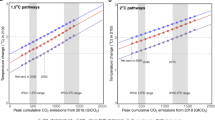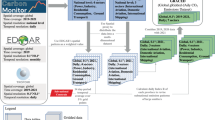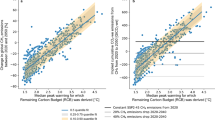Abstract
Efforts to limit climate change below a given temperature level require that global emissions of CO2 cumulated over time remain below a limited quota. This quota varies depending on the temperature level, the desired probability of staying below this level and the contributions of other gases. In spite of this restriction, global emissions of CO2 from fossil fuel combustion and cement production have continued to grow by 2.5% per year on average over the past decade. Two thirds of the CO2 emission quota consistent with a 2 °C temperature limit has already been used, and the total quota will likely be exhausted in a further 30 years at the 2014 emissions rates. We show that CO2 emissions track the high end of the latest generation of emissions scenarios, due to lower than anticipated carbon intensity improvements of emerging economies and higher global gross domestic product growth. In the absence of more stringent mitigation, these trends are set to continue and further reduce the remaining quota until the onset of a potential new climate agreement in 2020. Breaking current emission trends in the short term is key to retaining credible climate targets within a rapidly diminishing emission quota.
This is a preview of subscription content, access via your institution
Access options
Subscribe to this journal
Receive 12 print issues and online access
$259.00 per year
only $21.58 per issue
Buy this article
- Purchase on Springer Link
- Instant access to full article PDF
Prices may be subject to local taxes which are calculated during checkout




Similar content being viewed by others
References
Allen, M. R. et al. Warming caused by cumulative carbon emissions towards the trillionth tonne. Nature 458, 1163–1166 (2009).
Matthews, H., Gillett, N., Stott, P. & Zickfeld, K. The proportionality of global warming to cumulative carbon emissions. Nature 459, 829–832 (2009).
Meinshausen, M. et al. Greenhouse-gas emission targets for limiting global warming to 2°C. Nature 458, 1158–1162 (2009).
Raupach, M. R. The exponential eigenmodes of the carbon-climate system, and their implications for ratios of responses to forcings. Earth Syst. Dynam. 4, 31–49 (2013).
Raupach, M. R. et al. The relationship between peak warming and cumulative CO2 emissions, and its use to quantify vulnerabilities in the carbon-climate-human system. Tellus B 63, 145–164 (2011).
Zickfeld, K., Eby, M., Matthews, H. & Weaver, A. Setting cumulative emissions targets to reduce the risk of dangerous climate change. Proc. Natl Acad. Sci. USA 106, 16129–16134 (2009).
Gillett, N. P., Arora, V. K., Matthews, D. & Allen, M. R. Constraining the ratio of global warming to cumulative CO2 emissions using CMIP5 simulations. J. Clim. 26, 6844–6858 (2013).
van Vuuren, D. P. et al. Temperature increase of 21st century mitigation scenarios. Proc. Natl Acad. Sci. USA 105, 15258–15262 (2008).
Matthews, H. D., Solomon, S. & Pierrehumbert, R. Cumulative carbon as a policy framework for achieving climate stabilization. Phil. Trans. R. Soc. A 370, 4365–4379 (2012).
Zickfeld, K., Arora, V. K. & Gillett, N. P. Is the climate response to CO2 emissions path dependent? Geophys. Res. Lett. 39, L05703 (2012).
Joos, F. et al. Carbon dioxide and climate impulse response functions for the computation of greenhouse gas metrics: a multi-model analysis. Atmos. Chem. Phys. 13, 2793–2825 (2013).
IPCC in Climate Change 2013: The Physical Science Basis. (eds Stocker, T. F. et al.) 1–29 (Cambridge Univ. Press, 2013).
Maier-Reimer, E. & Hasselmann, K. Transport and storage of CO2 in the ocean — an inorganic ocean-circulation carbon cycle model. Clim. Dynam. 2, 63–90 (1987).
Friedlingstein, P. et al. Climate-carbon cycle feedback analysis: Results from the (CMIP)-M-4 model intercomparison. J. Clim. 19, 3337–3353 (2006).
Caldeira, K. & Kasting, J. F. Insensitivity of global warming potentials to carbon-dioxide emission scenarios. Nature 366, 251–253 (1993).
Collins, M. et al. in Climate Change 2013: The Physical Science Basis. (eds Stocker, T. F. et al.) Ch. 12, 1029–1136 (Cambridge Univ. Press, 2013).
Ciais, P. et al. in Climate Change 2013: The Physical Science Basis. (eds Stocker, T. F. et al.) Ch. 6, 465–570 (IPCC, Cambridge Univ. Press, 2013).
Knutti, R. & Hegerl, G. The equilibrium sensitivity of the Earth's temperature to radiation changes. Nature Geosci. 1, 735–743 (2008).
Gregory, J. M., Jones, C. D., Cadule, P. & Friedlingstein, P. Quantifying carbon cycle feedbacks. J. Clim. 22, 5232–5250 (2009).
Myhre, G. et al. in Climate Change 2013: The Physical Science Basis. (eds Stocker, T. F. et al.) Ch. 8, 659–740 (IPCC, Cambridge Univ. Press, 2013).
Bowerman, N. H. A. et al. The role of short-lived climate pollutants in meeting temperature goals. Nature Clim. Change 3, 1021–1024 (2013).
Smith, S. M. et al. Equivalence of greenhouse-gas emissions for peak temperature limits. Nature Clim. Change 2, 535–538 (2012).
Pierrehumbert, R. T. Short-lived climate pollution. Annu. Rev. Earth Planet Sci. 42, 341–379 (2014).
Clarke, L. et al. in Climate Change 2014: Mitigation of Climate Change. (eds Edenhofer, O. et al.) Ch. 6 (IPCC, Cambridge Univ. Press, 2014).
Rogelj, J. et al. Air-pollution emission ranges consistent with the representative concentration pathways. Nature Clim. Change 4, 446–450 (2014).
Collins, M. et al. in Climate Change 2013 The Physical Science Basis (eds Stocker, T. F. et al.) Ch. 12, 1029–1136 (IPCC, Cambridge Univ. Press, 2013).
Anderson, K., Bows, A. & Mander, S. From long-term targets to cumulative emission pathways: Reframing UK climate policy. Energy Policy 36, 3714–3722 (2008).
Anderson, K. & Bows, A. Beyond 'dangerous' climate change: emission scenarios for a new world. Phil. Trans. R. Soc. A 369, 20–44 (2011).
Allen, M. R. & Stocker, T. F. Impact of delay in reducing carbon dioxide emissions. Nature Clim. Change 4, 23–26 (2014).
Stocker, T. F. The closing door of climate targets. Science 339, 280–282 (2013).
Andres, R. J. et al. A synthesis of carbon dioxide emissions from fossil-fuel combustion. Biogeosciences 9, 1845–1871 (2012).
Andres, R. J., Boden, T. A. & Higdon, D. A new evaluation of the uncertainty associated with CDIAC estimates of fossil fuel carbon dioxide emission. Tellus B 66, 23616 (2014).
Francey, R. J. et al. Atmospheric verification of anthropogenic CO2 emission trends. Nature Clim. Change 3, 520–524 (2013).
Raupach, M. R., Quéré, C. L., Peters, G. P. & Canadell, J. G. Anthropogenic CO2 emissions. Nature Clim. Change 3, 603–604 (2013).
Francey, R. J. et al. Reply to 'Anthropogenic CO2 emissions'. Nature Clim. Change 3, 604–604 (2013).
Raupach, M. R. et al. Global and regional drivers of accelerating CO2 emissions. Proc. Natl Acad. Sci. USA 104, 10288–10293 (2007).
Pielke R. Jr The Climate Fix (Basic Books, 2010).
Le Quéré, C . et al. Trends in the sources and sinks of carbon dioxide. Nature Geosci. 2, 831–836 (2009).
Friedlingstein, P. et al. Update on CO2 emissions. Nature Geosci. 3, 811–812 (2010).
Peters, G. P. et al. Rapid growth in CO2 emissions after the 2008–2009 global financial crisis. Nature Clim. Change 2, 2–4 (2012).
Peters, G. P. et al. The challenge to keep global warming below 2 °C. Nature Clim. Change 3, 4–6 (2013).
Le Quéré, C. et al. Global carbon budget 2013. Earth Syst. Sci. Data 6, 235–263 (2014).
Davis, S. J. & Caldeira, K. Consumption-based accounting of CO2 emissions. Proc. Natl Acad. Sci. USA 107, 5687–5692 (2010).
Peters, G. P., Minx, J. C., Weber, C. L. & Edenhofer, O. Growth in emission transfers via international trade from 1990 to 2008. Proc. Natl Acad. Sci. USA 108, 8903–8908 (2011).
World Economic Outlook: Recovery Strengthens, Remains Uneven (IMF, 2014); http://www.imf.org/external/ns/cs.aspx?id=29
World Economic Outlook Update: An Uneven Global Recovery Continues (IMF, 2014); http://www.imf.org/external/pubs/ft/weo/2014/update/02
Houghton, R. A. et al. Carbon emissions from land use and land-cover change. Biogeosciences 9, 5125–5142 (2012).
Le Quéré, C. et al. Global carbon budget 2014. Earth Syst. Sci. Data Discuss. 10.5194/essdd-7-521-2014 (2014).
Giglio, L., Randerson, J. T. & van der Werf, G. R. Analysis of daily, monthly, and annual burned area using the fourth-generation global fire emissions database (GFED4). J. Geophys. Res. Biogeosci. 118, 317–328 (2013).
Deser, C., Knutti, R., Solomon, S. & Phillips, A. S. Communication of the role of natural variability in future North American climate. Nature Clim. Change 2, 775–779 (2012).
Tebaldi, C. & Friedlingstein, P. Delayed detection of climate mitigation benefits due to climate inertia and variability. Proc. Natl Acad. Sci. USA 110, 17229–17234 (2013).
Ricke, K. L. & Caldeira, K. Natural climate variability and future climate policy. Nature Clim. Change 4, 333–338 (2014).
van Vuuren, D. P. et al. RCP3-PD: Exploring the possibilities to limit global mean temperature change to less than 2 °C. Climatic Change 109, 95–116 (2011).
Azar, C., Lindgren, K., Larson, E. & Mollersten, K. Carbon capture and storage from fossil fuels and biomass - Costs and potential role in stabilizing the atmosphere. Climatic Change 74, 47–79 (2006).
Azar, C. et al. The feasibility of low CO2 concentration targets and the role of bio-energy with carbon capture and storage (BECCS). Climatic Change 100, 195–202 (2010).
Tavoni, M. & Socolow, R. Modeling meets science and technology: an introduction to a special issue on negative emissions. Climatic Change 118, 1–14 (2013).
van Vuuren, D. P. & Riahi, K. The relationship between short-term emissions and long-term concentration targets. Climatic Change 104, 793–801 (2011).
Boucher, O. et al. Reversibility in an Earth System model in response to CO2 concentration changes. Environ. Res. Lett. 7, 024013 (2012).
Vichi, M., Navarra, A. & Fogli, P. G. Adjustment of the natural ocean carbon cycle to negative emission rates. Climatic Change 118, 105–118 (2013).
Long, C. & Ken, C. Atmospheric carbon dioxide removal: long-term consequences and commitment. Environ. Res. Lett. 5, 024011 (2010).
Kriegler, E., Edenhofer, O., Reuster, L., Luderer, G. & Klein, D. Is atmospheric carbon dioxide removal a game changer for climate change mitigation? Climatic Change 118, 45–57 (2013).
Kriegler, E. et al. The role of technology for achieving climate policy objectives: overview of the EMF 27 study on technology and climate policy strategies. Climatic Change 123, 353–367 (2013).
Luderer, G. et al. Economic mitigation challenges: how further delay closes the door for achieving climate targets. Environ. Res. Lett. 8, 034033 (2013).
Riahi, K. et al. in Global Energy Assessment — Toward a Sustainable Future Ch. 17, 1203–1306 (Cambridge Univ. Press and IIASA, 2012).
Riahi, K. et al. Locked into Copenhagen pledges — Implications of short-term emission targets for the cost and feasibility of long-term climate goals. Technol. Forecas. Soc. Change http://dx.doi.org/10.1016/j.techfore.2013.09.016 (2013).
Rogelj, J., McCollum, D. L., O'Neill, B. C. & Riahi, K. 2020 emissions levels required to limit warming to below 2 °C. Nature Clim. Change 3, 405–412 (2013).
Rogelj, J., McCollum, D. L., Reisinger, A., Meinshausen, M. & Riahi, K. Probabilistic cost estimates for climate change mitigation. Nature 493, 79–83 (2013).
van Vliet, J. et al. Copenhagen Accord Pledges imply higher costs for staying below 2 °C warming. Climatic Change 113, 551–561 (2012).
World Energy Investment Outlook (IEA, 2014).
Annual Energy Outlook (EIA, 2014).
Höhne, N. et al. National GHG emissions reduction pledges and 2 °C: comparison of studies. Climate Policy 12, 356–377 (2012).
The Emissions Gap Report 2012 (UNEP, 2012).
The Emissions Gap Report 2013 64 (UNEP, 2013).
Kriegler, E. et al. Making or breaking climate targets: The AMPERE study on staged accession scenarios for climate policy. Technol. Forecas. Soc. Change http://dx.doi.org/10.1016/j.techfore.2013.09.021 (2014).
Kriegler, E. et al. What does the 2 °C target imply for a global climate agreement in 2020? The LIMITS study on Durban Platform scenarios. Clim. Change Econ. 4, 1340008 (2013).
Schaeffer, M. et al. Mid- and long-term climate projections for fragmented and delayed-action scenarios. Technol. Forecas. Soc. Change http://dx.doi.org/10.1016/j.techfore.2013.09.013 (2013).
Johnson, N. et al. Stranded on a low-carbon planet: Implications of climate policy for the phase-out of coal-based power plants. Technol. Forecas. Soc. Change http://dx.doi.org/10.1016/j.techfore.2014.02.028 (2014).
Luderer, G., Bertram, C., Calvin, K., De Cian, E. & Kriegler, E. Implications of weak near-term climate policies on long-term mitigation pathways. Climatic Change http://dx.doi.org/10.1007/s10584-013-0899-9 (2013).
Lenton, T. M. et al. Tipping elements in the Earth's climate system. Proc. Natl Acad. Sci. USA 105, 1786–1793 (2008).
Matthews, H. D. & Caldeira, K. Stabilizing climate requires near-zero emissions. Geophys. Res. Lett. 35, L04705 (2008).
Raupach, M. R. et al. Sharing a quota on cumulative carbon emissions. Nature Clim. Change http://dx.doi.org/10.1038/nclimate2384 (2014).
Boden, T. A., Marland, G. & Andres, R. J. Global, Regional, and National Fossil-Fuel CO2 Emissions in Trends (Carbon Dioxide Information Analysis Center, Oak Ridge National Laboratory, US Department of Energy, 2013); http://cdiac.ornl.gov/trends/emis/em_cont.html
Statistical Review of World Energy June 2013 (BP, 2013).
CO2 emissions from fuel combustion 2013 (IEA, 2013).
AR5 Scenario Database (IIASA, 2014); https://secure.iiasa.ac.at/web-apps/ene/AR5DB/
Acknowledgements
P.F. was supported by the European Commission's 7th Framework Programme (EU/FP7) under Grant Agreements 282672 (EMBRACE) and 603864 (HELIX). G.P.P. and R.M.A. were supported by the Norwegian Research Council (236296). J.G.C. acknowledges the support from the Australian Climate Change Science Program. C.L.Q. was supported by the UK Natural Environment Research Council (NERC)'s International Opportunities Fund (project NE/103002X/1) and EU/FP7 project 283080 (GEOCarbon). This work is a collaborative effort of the Global Carbon Project (http://www.globalcarbonproject.org).
Author information
Authors and Affiliations
Contributions
P.F., G.P.P., J.G.C., J.R. and C.L.Q. designed the study. P.F. coordinated the conception and writing of the paper. R.M.A. and G.P.P. provided data and analysis on historical and near-term projections of emissions, GDP and carbon intensity. M.S. provided all data on cumulative emission budgets compatible with warming levels from the IPCC WGII scenarios database. J.R. and G.L. coordinated the assessment of trade-offs in delayed action scenarios. R.M.A. produced Figs 1 and 2. J.R. produced Figs 3 and 4. All authors contributed to the writing of the paper.
Corresponding author
Ethics declarations
Competing interests
The authors declare no competing financial interests.
Supplementary information
Supplementary Information
Cumulative budgets and uncertainty (PDF 1162 kb)
Rights and permissions
About this article
Cite this article
Friedlingstein, P., Andrew, R., Rogelj, J. et al. Persistent growth of CO2 emissions and implications for reaching climate targets. Nature Geosci 7, 709–715 (2014). https://doi.org/10.1038/ngeo2248
Received:
Accepted:
Published:
Issue Date:
DOI: https://doi.org/10.1038/ngeo2248
This article is cited by
-
Boosting a practical Li-CO2 battery through dimerization reaction based on solid redox mediator
Nature Communications (2024)
-
Efficient CO2 methanation using nickel nanoparticles supported mesoporous carbon nitride catalysts
Scientific Reports (2023)
-
Binuclear Cu complex catalysis enabling Li–CO2 battery with a high discharge voltage above 3.0 V
Nature Communications (2023)
-
Irreversible loss in marine ecosystem habitability after a temperature overshoot
Communications Earth & Environment (2023)
-
Calculation of carbon emission efficiency in China and analysis of influencing factors
Environmental Science and Pollution Research (2023)



